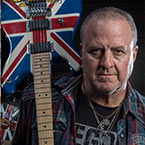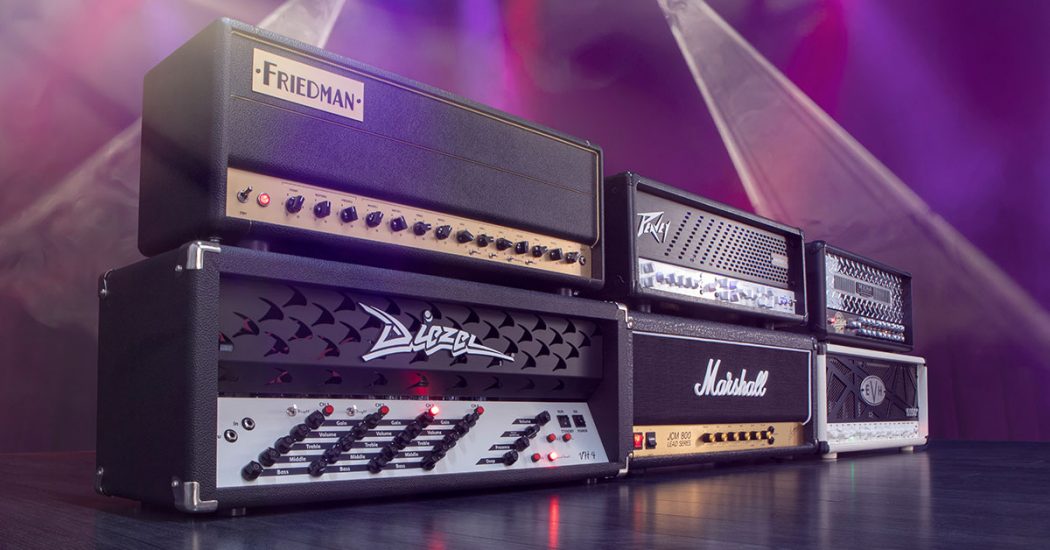
a.k.a. “15 Cranium-crushing Heads!”
“Best” is a weird and wonderful term, especially when related to something as subjective as guitar amps and tone. As an ancient adage so wisely states, “one man’s meat is another man’s poison.” So my “best 15” could well be completely different from yours — as could my take on what is or isn’t “metal”! That said, without further ado, here’s my personally approved list of “15 Best Guitar Amps for Metal” while taking into account both old-school and new-school metal as best I can.
First though, I must point out five quick things:
- This list is in no specific order!
- None of the amps in this list are one-trick, metal-only ponies! They’re all great for other genres from country to blues to classic rock and, furthermore, are used as such. That stated, they’re all obviously more than capable of creating marvelous metal mayhem!
- The ability for the chosen amps to be able to “chug” (and for some “djent” — read on!) with aggressive authority and definition at high-gain settings is a no-exceptions must for this list!
- I’m going to be talking about heads not combos. Why? Because we’re talking about metal here, and IMHO, said art form is all about stacks.
- For certain manufacturers, I will be including an “honorary mention” product. And if a lower-wattage option is available, I’ll probably mention that too, as we’re not all playing stadiums!
Here are my picks for the Best Guitar Amps for Metal.
Best Guitar Amps for Metal:
Marshall JCM800 2203X
There’s simply no way this legendary British-born beast could not be mentioned in this list, as the JCM800 family of heads literally owned the burgeoning metal scene on both sides of the Atlantic in the ’80s. And the 100-watt 2203, with its trademark “punch in the chest” roar, was the patriarch of the JCM tribe. In addition to its gloriously aggressive voice, the beauty of this head is its simplicity — one channel of no-nonsense, all-tube (3 x 12AX7, 4 x EL34) brutality.
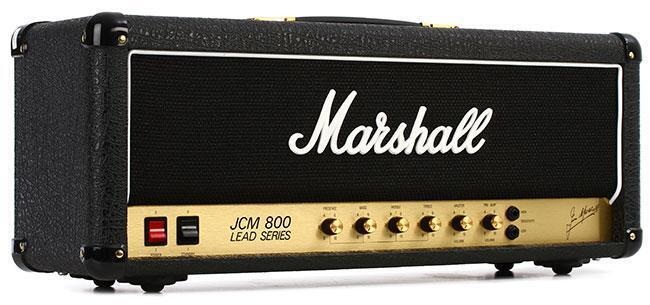
The 2203X is a reissue of the head that dominated a metal decade with one cool addition — a true bypass series effects loop. Now by today’s standards, this head is not what most would call a high-gain amp, but front-ending a 2203X with a Tube Screamer, boost, or OD pedal will get you exactly where you need to get with the mere stomp of your foot.
The list of famous 2203-abusing metal titans is a lengthy one that includes the likes of Slayer, Zakk Wylde, Judas Priest, Iron Maiden, and a slew of others. And if 100 watts is just too much juice for your needs (and for a lot of small venues it is), Marshall also offers a 20/5-watt version — the SC20H Studio Classic tube head.
Honorary Mention: Marshall JVM410H. If you need a high-gain 100-watt tube Marshall head with four independent channels, 12 modes (three per channel), and a slew of other features, look no further.
Best Guitar Amps for Metal:
Mesa/Boogie Dual Rectifier
When Mesa/Boogie’s Rectifier heads were unleashed in the early ’90s, their thick yet well-defined wall of distortion quickly made them “the new sheriff in metal town.” And some 30 years later, the Dual Rectifier is still rightfully considered one of the industry standards when it comes to high-gain amps.
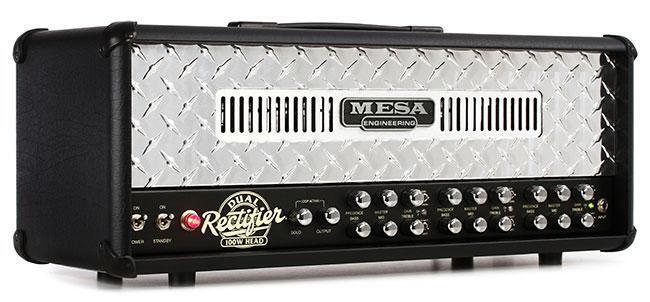
This amp is loaded with a ton of cool features, including a switchable choice of tube or solid-state rectification*, three footswitchable channels with voicing options, an effects loop, a 6L6/EL34** Bias switch, plus a footswitchable Solo level for — wait for it — soloing! As a result, this highly versatile, diamond-plated 100-watt all-tube (5 x 12AX7, 2 x 5U4, 4 x 6L6) head is a monstrous, high-gain force to be reckoned with.
*Note 1: A rectifier converts AC (alternating current) to DC (direct current). In simple “guitarist-friendly” terms, the difference between a tube rectifier and a solid-state one is this: an amp with a tube rectifier invariably sounds much looser or spongier in the bottom end. This is because of the voltage drop, or sag, that occurs in the rectifier tube when the amp is cranked. The same exact amp with a solid-state rectifier will have a tighter, punchier, more articulate low end and more headroom. In short, the solid-state option on the Dual Rectifier is definitely the way to go for metal! In addition to the Dual Rectifier’s instantly recognizable diamond-faceplate aesthetic, it is also available in black and “blacked out” finishes too.
**Note 2: The amp comes loaded with 6L6 output tubes — the Bias switch just makes it much easier to change over to EL34 output tubes, should you decide to do that. And if you’re wondering what the tonal characteristic differences between EL34s and 6L6s are, read on…
Famous metal Rectifier users, past and present, include Godsmack, Kirk Hammett (Metallica), Korn, Daron Malakian (System of a Down), Bullet for My Valentine, and countless others.
Honorary Mention: Mesa/Boogie Mark Five: 25. Looking for a versatile, high-gain, low-wattage Mesa tube head? With two independent channels, 5-band graphic EQ, spring reverb, a built-in Cabclone speaker simulator and load box, and more? If so, this one is well worth checking out.
Best Guitar Amps for Metal:
EVH 5150 III 50W EL34
The eye-catching 5150 III 50W EL34 sounds as good as it looks, and if you’re a fan of Edward Van Halen, that will come as no surprise — after all, this living legend is a self-professed “tone chaser.” The 50-watt tube-driven head is armed with three channels that will take you from beautiful clean to brutal, densely overdriven carnage and all points in between. It also has an effects loop and a MIDI input. Its dual EL34 output tubes give it a distinctly “British” flavor, and if you want to super-size this sucker, it also has a 100-watt big brother. Also, if you prefer the more “American” sound that 6L6 power tubes deliver, EVH sensibly offers those options too — clad in black or ivory vinyl.
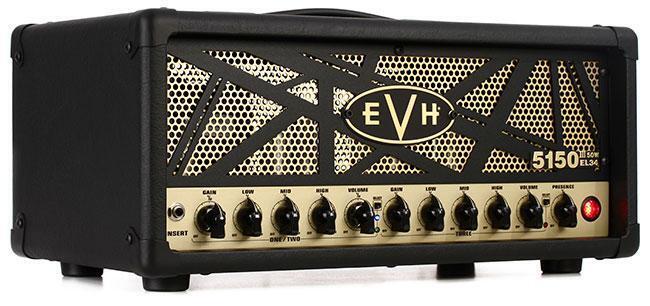
Tonal Sidebar: In a simplistic nutshell, the sonic difference between 6L6 and EL34 power/output tubes is as follows: EL34s overdrive quicker and have a strong, girthy midrange; 6L6s have more headroom, less mids, and are well balanced across the guitar’s entire frequency range from high to low. As EL34s were the output tube of choice in pivotal British rock amps, such as Sound City, Hiwatt, and especially Marshall, they’re synonymous with that big, gnarly, crunchy “British sound.” Similarly, 6L6s are considered “American” or even “Californian” due to their use in so many landmark US amps from the likes of Fender and Mesa/Boogie.
Important Note: The differences between 6L6s and EL34s can be best heard and also felt when the amp is being pushed without too much preamp gain, as that can mask the sometimes subtle characteristics of these fine output tube options. So turn yer gain control down and crank the volume to really appreciate the difference.
Honorary Mention: EVH 5150III LBXII. With two channels, an effects loop, and a 1/4 power switch, this 15-watt tube amp is perfect for home use or those gigs where that pesky soundman keeps telling you to turn down!
Best Guitar Amps for Metal:
Peavey Invective.120
In the world of modern metal where the use of the playing style known as “djent”* is considered mandatory, Misha Mansoor of Periphery is deservedly heralded as a frontrunner by many. Not surprisingly, Mr. Mansoor has his own signature Peavey head: the Invective.120. And, as you’d probably expect, this 120-watt tube head is an over-the-top modern metal “djent” machine that’s equally good at old-school metal chugging and some cool clean tones too.
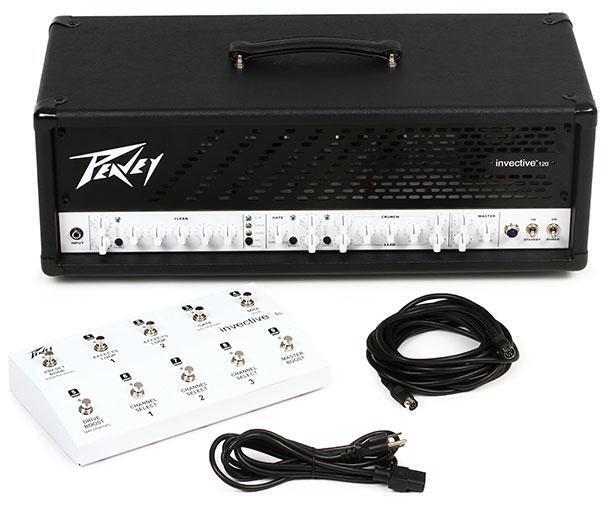
It has three channels (each with its own footswitchable drive boost), a built-in noise gate with a superfast response (vital for those tight, syncopated djent moments), MIDI, a sturdy 10-button footswitch, two effects loops, and more.
Even though this amp has a Half-power switch, if 60 watts is still too much, it has a much smaller sibling, the Peavey Invective MH, so you can djent away to your heart’s delight at small club and even bedroom-friendly volumes.
*Trivia: The term “djent” is used to describe percussive, palm-muted chugging on low-tuned axes into extremely overdriven amps where rhythmic precision is key. The birth of the term is attributed to the mighty Meshuggah who used it to describe the sound of the aforementioned technique. Some folk even consider “djent” to be a metal subgenre.
Important PS: In case the word is new to you, the “d” in “djent” is silent. Thus, the word “djent” is pronounced “gent.”
Honorary Mention: Peavey 6505. This popular amp is based on the company’s highly successful 5150 series that explosively emerged in the early ’90s. Its perfect predisposition for metal was proven by its use on many classic ’90s metal albums, including Machine Head’s stunning 1994 debut, Burn My Eyes.
Best Guitar Amps for Metal:
Friedman JJ-100 Jerry Cantrell Signature
In the world of building, modding, and repairing amps for guitar heroes, Dave Friedman needs no introduction — and neither do the fire-breathing heads, such as the BE-100 and the BE-50 Deluxe, that bear his name. One of the many stars he’s worked with is riff and tone master Jerry Cantrell of Alice in Chains (AIC). Enter the Friedman JJ-100 Jerry Cantrell Signature 100-watt tube head.
Jerry and Dave spent several years perfecting this EL34-powered, 100-watt, 2-channel colossus that captures both the complex cleans and devilishly dirty yet articulate tones that have made Mr. Cantrell’s signature sounds so desirable. The magic switch labeled “JBE” can be found on the JJ’s rear panel, and when activated, that aggressive AIC tone beast is unleashed. Add to that Friedman’s critically acclaimed effects loop, custom transformers, plus the aforementioned clean channel, and the handbuilt JJ is indeed “lightning in a bottle.”
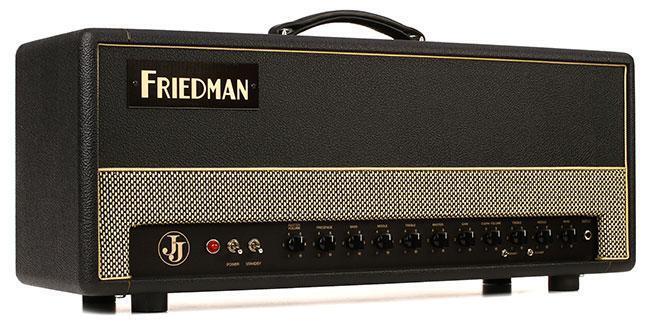
The JJ-100 has been cleverly designed to deliver a full, fat, “the power stage is cranked” sound at (surprisingly) low volumes. If you’d prefer something smaller though, the compact JJ-JUNIOR Jerry Cantrell Signature 20-watt tube head is just the ticket.
Honorary Mention: Friedman BE-100 Deluxe. Mr. Friedman considers this highly versatile amp to be his “new flagship.” Enough said.
Best Guitar Amps for Metal:
Diezel VH4
This Teutonic titan is built like a tank, and its fearsome tonal firepower made it an instant favorite with metal’s most influential players (including James Hetfield of Metallica and Adam Jones of Tool — need I say more?) from the very moment it first reared its head in the mid-1990s. A quarter of a century later, the VH4 remains iconic in metal’s darkened domain and deservedly so.
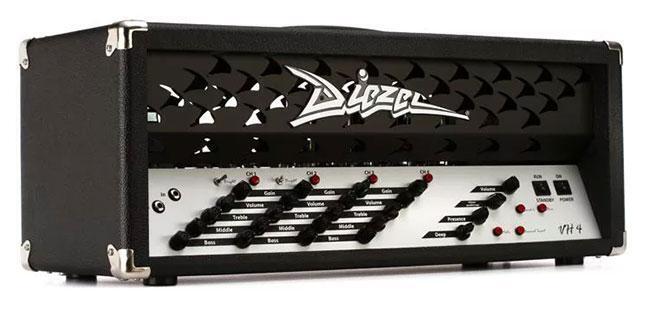
Featuring four completely independent channels (each with its own series effects insert), global series and parallel effects loops, MIDI switching, and KT77 power tubes, the VH4 is a “wish list” head for many metal-loving guitarists. As great as each of the quartet of channels is though, the one that made the VH4 an instant must-have hit is Channel 3. Why? Its unique marriage of articulate, touch-sensitive high gain and powerful, tight lows.
Honorary Mention: Diezel VH2. As great as the VH4 is, it’s not exactly a “budget” item, and understandably, its four channels and features can be a little intimidating. Enter this more streamlined and wallet-friendly 2-channel, 100-watt tube head.
Best Guitar Amps for Metal:
Orange Rockerverb 100 MKIII
Since this British-born company’s “second coming” in 1997, their no-nonsense tube amps have made a great deal of headway (bad pun intended!) in the world of hard rock and metal. And with such artists as Andreas Kisser (Sepultura), Pepper Keenan and Bobby Landgraf (Down), Kirk Windstein (Crowbar), Jim Root (Slipknot), and Brent Hinds (Mastodon) using their wares, Orange’s high-gain amps clearly “do metal” well!
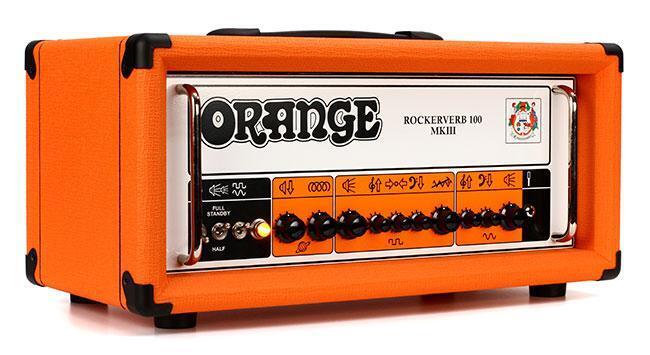
One of their most popular offerings is the 100-watt Rockerverb 100 MKIII. This tube head (4 x 12AX7, 2 x 12AT7, 4 x EL34) has two channels: Clean and Dirty. The latter goes from AC/DC-approved crunch to modern high-gain grind and all points in between. Onboard power scaling via the front-panel Full/Half power switch and the rear-panel “4 Output Valves/2 Output Valves” switch allows you to select one of the following four output wattage options: 100, 70, 50, or 30. Pretty cool. Add to that a footswitchable attenuator control, spring reverb, and an effects loop, and you have a lot of options. The Rockerverb is, of course, available covered in the brand’s trademark orange Tolex, but if you’d prefer something darker looking, it is also offered in black Tolex.
Honorary Mention: Orange Dark Terror. Ever since Orange let loose the first Tiny Terror way back in 2007, “lunchbox” amps have been incredibly popular. The Dark Terror is the high-gain member of this compact family.
Best Guitar Amps for Metal:
Blackstar HT Stage 100 MkII
Blackstar was born in 2004 when four friends left a famous British amp brand beginning with “M” in order to form a company of their own. They did very well, and within only a few years, Blackstar amps were considered a force to be reckoned with in the world of rock.
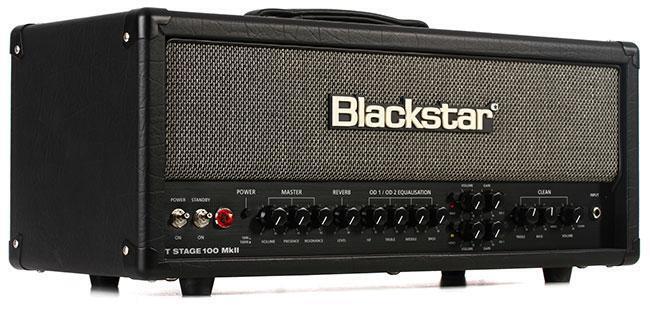
The 3-channel Blackstar HT Stage 100 MkII is a flexible and affordable tube head that has several features that really help you sculpt your sound. In addition to the company’s Infinite Shape Feature (ISF) control, which takes you from a classic British vibe to a more aggressive American one and all points in between, it also has Voice switches on the two OD channels that can add further to your tonal angst. A Resonance control in the Master section will also add extra low-end “thump,” should you need it.
Honorary Mention: Blackstar HT5RH MkII. You obviously don’t have to be in a band to enjoy playing and recording metal. This diminutive 2-channel tube monster includes a 5/0.5-watt switch, digital reverb, ISF, a line-in, USB audio output, and a speaker-emulated output. So, from bedroom to recording to “silent stage” applications, this is a worthy choice.
Best Guitar Amps for Metal:
PRS Archon 100
There’s always that guy who will say, “but PRS makes guitars, not amps.” The conversation-ending answer to such an asinine statement is two powerful words: Leo Fender! Yep, PRS does build fine guitars and also makes fine amps too. Furthermore, the Archon (a Greek word meaning “lord” or “ruler”) is a 100-watt tube head (6 x 12AX7, 4 x 6L6) designed specifically for high-gain, drop-tuned metal. Oh, and it has a cool, independent clean channel too!
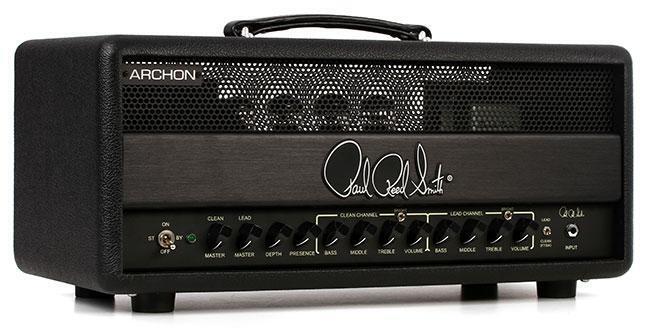
Armed with five cascading gain stages, the Archon delivers “none-more” distortion while maintaining articulation and note clarity. Both channels have their own Master volume control to ensure perfect balance — that plus a footswitchable effects loop, a Depth control, and a half-power switch on the rear panel add to the Archon’s appeal. It also has a 50-watt sibling that can drop down to 25 watts.
Honorary Mention: PRS Mark Tremonti MT15. Don’t let the diminutive size of this “lunchbox-style” 2-channel amp fool you — just like the Alter Bridge/Creed axeman, it packs a mean metal punch and a sparkling clean sound too. The MT15 also has an effects loop, and its aesthetic is “none more black.”
Best Guitar Amps for Metal:
Bogner Uberschall Twin Jet
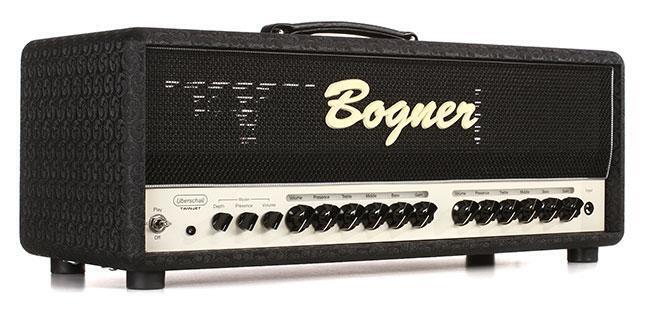
In the rarified atmosphere of boutique amps that 6-string superstars drool over, Bogner is a well-known and respected name — especially when followed with a word such as “Uberschall” or “Ecstasy.” A German word meaning “supersonic” or “ultrasonic,” the Uberschall Twin Jet 150-watt amp is the evolution of the original version that helped put Bogner on the map. Boasting two channels and a buffered effects loop, this handwired tube head (6 x 12AX7, 4 x KT88) is a high-gain metal Panzer. Definitely not for the faint of heart!
Best Guitar Amps for Metal:
Hughes & Kettner Triamp MkIII
The proud flagship of the Hughes & Kettner line, the 150-watt, dual 3-channel programmable Triamp MkIII’s front panel alone is armed with 33 controls and 13 switches — not counting those labeled “Power” and “Standby.” Phew! These stats plus “dual 3-channel programmable” make it crystal clear that this amp is literally packed full of features. For a more comprehensive list of those features, please visit our product page and watch the videos there. Here’s a few pertinent ones for metal stormtroopers though.
The six channels (dual 3-channel — geddit?) include a trio of metal-biased brutes, namely: ’80s Brown Sound (Channel 2B), California High Gain (3A), and Modern High Gain and Beyond (3B). There’s also an effects loop, an onboard noise gate, and three pairs of freely assignable power tubes that you can mix and match both output wattage and output stage voice. The three pairs are two EL34s (50 watts of British tone) and two pairs of 6L6s (both boasting 50 watts of USA tone). Make sense? Oh, if that’s not enough, it has MIDI capabilities too.
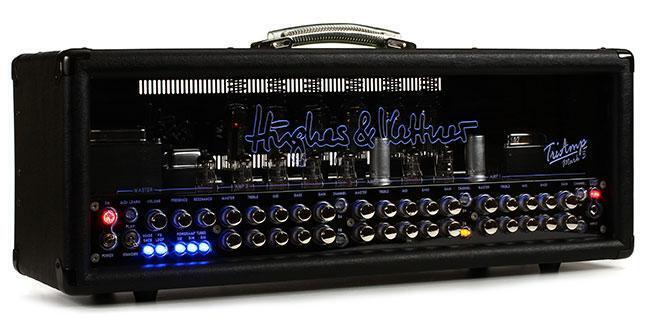
Honorary Mention: Hughes & Kettner Black Spirit 200. This solid-state amp emulates famous amps without digitizing your signal. How? By switching around analog components. Like the Triamp, this 4-channel amp, with 128 preset locations and built-in effects, is packed with features and possibilities.
Best Guitar Amps for Metal:
Rivera Knucklehead Tre Reverb
As the moniker “Knucklehead” implies, when it comes to super-high gain, this 2-channel all-tube amp (5 x 12AX7, 4 x EL34) isn’t messing around! It’s a very intuitive amp to dial in and features a useful Foundation control that allows you to dial in a bottom-end gain “bump” to suit those low, low tunings.
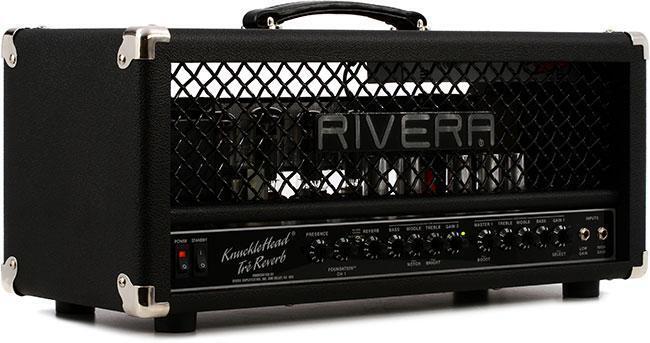
The Knucklehead Tre Reverb houses a 3-spring reverb, an effects loop, and a balanced DI. It’s also built like a tank, utilizing military-grade components and an oversized transformer for even more “umph.” A 4-way footswitch is also included.
Honorary Mention: Rivera KR7 Mick Thomson Signature. What is armed with a subwoofer output plus designed and used by Slipknot’s sonically and visually intimidating axeman with the psychotic-looking metal mask? This amp is. Some amps go to “11” — this one goes to “Seven,” and trust me, that’s enough!
Best Guitar Amps for Metal:
BOSS Katana-Head MkII
After all the tube behemoths in this list, the inclusion of an extremely affordable solid-state head made by a leading stompbox company might well surprise you… unless you’ve played a Katana, of course. The BOSS Katana-Head MkII is no toy; it’s a powerful weapon that can hold its own both in the studio and on the stage. It can store and recall eight presets and offers eight electric guitar amp voicings, over 60 BOSS effects, an effects loop, cab-emulated line and headphone/record outputs, and a whole bunch more.
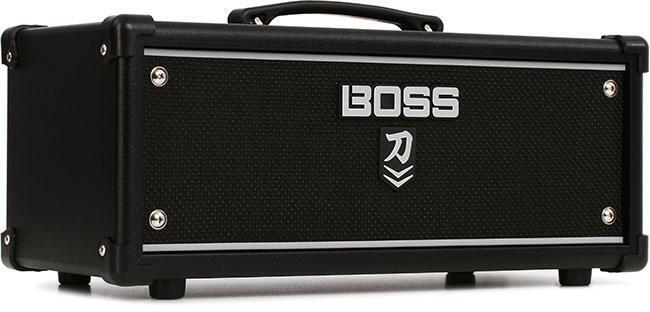
Programming and then saving a setting via the easy-to-understand controls is simple, and the free BOSS Tone Studio software is extremely intuitive to use too. Plus, the Tone Studio allows you to deep dive into both effect selection and tweaking. More importantly, the amp sounds and feels great, and both the Lead and Brown amp voices are perfect platforms for dialing in cutting metal tones.
Best Guitar Amps for Metal:
Kemper Profiler PowerRack
Tube and analog purists may well balk at the inclusion of this digital marvel in this list, but the Kemper Profiler PowerRack is included and deservedly so. As the saying goes, “the numbers don’t lie,” and in this case, the Kemper user list doesn’t lie either: from a trio of metal’s foremost producers — Kevin Churko, Andy Sneap, and Michael Wagener — to such highly respected players as Dino Cazares (Fear Factory), Tommy Victor (Prong), Matt Heafy (Trivium), Jon Donais (Anthrax), Alex Skolnick (Testament), and many more. Like it or loathe it, the list is as impressive as it is long.
In a nutshell, what “profiling” means is that the Kemper takes a digital sonic snapshot of your favorite rig at your favorite setting and saves it. And it can do this literally hundreds of times. Each one comes preloaded with over 300 profiles to do with what you want, and literally thousands are available online. And due to rising transport and excess luggage charges on airlines, for hard-touring guitarists who don’t like to put their trust in rented gear at every gig, Kemper is a tone saver.
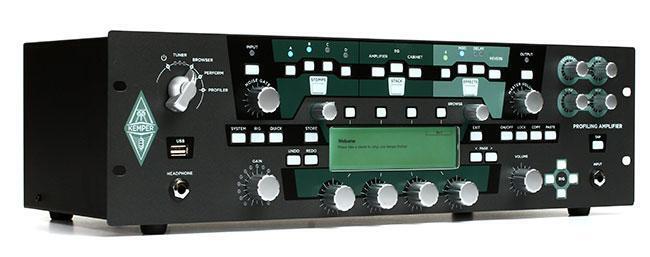
…and last, but certainly not least, a Sweetwater exclusive:
Best Guitar Amps for Metal:
Lerxst Omega
In the world of hard rock, Alex Lifeson and Rush need no introduction — they’re both rightfully hailed as legends. Now, while the more extreme metal fan might consider Rush anything but metal, believe me when I tell you that this tube amp (3 x 12AX7, 4 x EL34) is capable of cranium crushing with the best of them, especially if you hit the front end with a boost or OD pedal.
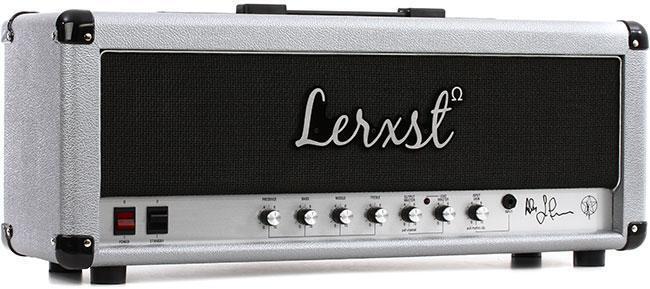
As its eye-catching silver vinyl livery might well tell you, this limited-edition beauty is based on an iconic British head circa 1987. Boasting KISS (Keep It Simple, Stupid!) controls, the Omega’s Lead channel maintains clarity and note definition, even when cranked to “11.” Each one has been meticulously handwired in the good ol’ US of A, and each one has been signed by Mr. Lifeson himself. Only 100 were made, and when they’re gone, they’re gone — so get yours now.
Summary and Sayonara
Phew! And that, my friend, concludes this list. As I stated in my preamble, at the end of the day, tone — like musical taste — is both subjective and highly personal. And the way any amp sounds and feels is highly dependent on who is playing what through it.
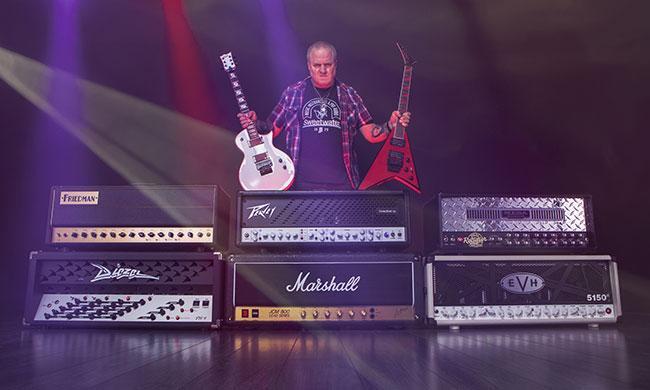
My parting advice? Try as many amp options as you can, preferably using your guitar to limit the unknowns as much as possible. Don’t be scared to ask questions of others, but when all is said and done, please make your choice with your fingers, ears, and heart. Remember, the only opinion that ultimately matters is yours! Good hunting…
If you are interested in any of the amps listed here, then please give your Sales Engineer a call at (800) 222-4700!


